1/1/2020
A Day at the Circus
Jennifer Zurko
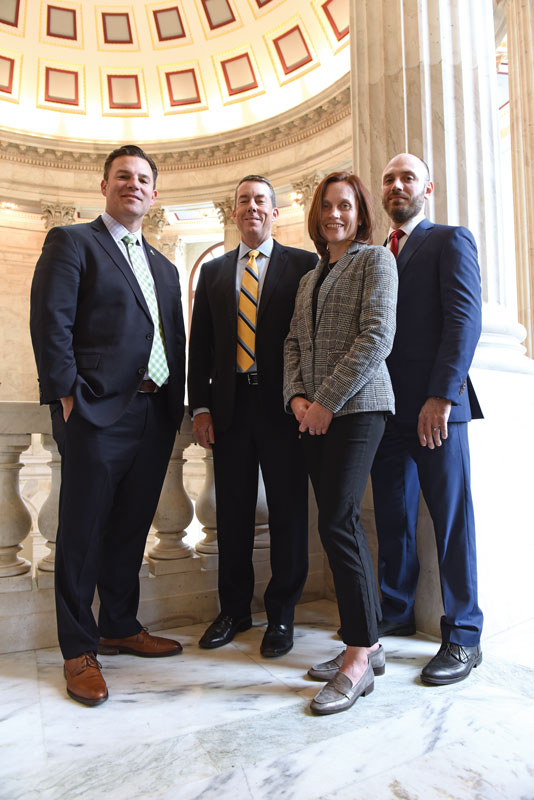
In 1986, Ronald Reagan was president, the Chicago Bears did the “Super Bowl Shuffle” (editorial comment: and haven’t done much since), Madonna and Bon Jovi were at the top of the charts, and your humble scribe was 10 years old.
That was the last time the House of Representatives passed significant farm labor legislation—until this past December when the House passed the Farm Workforce Modernization Act (H.R. 5038), which includes improvements to the H-2A program that will essentially make it easier for you to get the guest workers that you need.
As of press time right before Christmas, the bill passed the house by a bipartisan 260-165 vote, giving it the go-ahead to go to the Senate. But before H.R. 5038 was put to a vote, there were months of hard work that had to be done in order to get it there. This is a small glimpse into that story.
If you don’t already know, AmericanHort has been gradually building its advocacy team. For over 30 years, Craig Regelbrugge has been representing nursery, landscape and greenhouse growers in Washington D.C., first for the American Nursery & Landscape Association and now for AmericanHort when ANLA merged with OFA seven years ago.
In the last four years, it’s gone from a two-man-show to a small team of regulatory and legislative professionals. Dr. Jill Calabro, Science and Research Programs Director, handles crop protection and the regulations that go along with that as the liaison between our industry and government bodies like the USDA, APHIS, ARS and EPA. She’s also heavily involved with coordinating funding for research projects.
Tal Coley is Director of Government Affairs and Craig’s right-hand-man, helping him coordinate meetings with Congressional offices and handling comments for new legislation. His latest focus has been on the latest trucking regulations, which includes Electronic Logging Devices tied to hours-of-service rules.
Tristan Daedalus, Director of Advocacy and Policy Communications, is the newest hire, joining AmericanHort during the summer of 2019. He’s in charge of making sure the word gets out about what the advocacy team is up to—everything from new legislation efforts to special events and to everyone from the trade press to the mainstream media.
Ken Fisher is President and CEO of AmericanHort and it was fortuitous that he happened to be in D.C. when I arrived. I wanted to get his thoughts on the organization’s advocacy efforts and how they benefit their members.
Wednesday, 2:00 p.m.
GrowerTalks photographer Mark Widhalm and I arrive at AmericanHort’s offices to touch base before heading to the Hill the next day. I chatted with Tal, Tristan and Ken while Mark snapped some photos. I waved to Craig through his office window as he was busy on a call. He was still on the phone when we left over an hour later. I will soon begin to realize that there’s a pattern of Craig constantly being on the phone, either talking, texting or checking email.
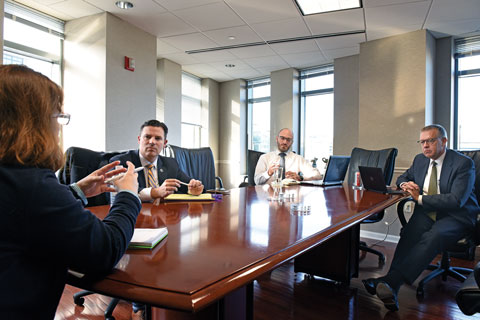 Pictured from left to right: Tal Coley, Tristan Daedalus and Ken Fisher, with me in the left-hand foreground.
Pictured from left to right: Tal Coley, Tristan Daedalus and Ken Fisher, with me in the left-hand foreground.
“For me, out of all the things a trade association is supposed to do, advocacy is really one of the key pillars that we have to be good at for our industry to be successful and healthy,” said Ken. “I think our [association] does a very good job of representing our industry to protect us from a regulatory and legislative standpoint. And I’d like to think that we’re getting pretty good at it.”
One of the primary reasons OFA and ANLA merged was because OFA needed a better advocacy arm of their association. Gone were the days where you could lament about the state of our politics/government from your kitchen table or bar stool—legislation and regulations that were being passed were more directly affecting your greenhouse or garden center. And during the last decade, more green business owners have found themselves much more actively involved in local and national politics.
But not even the largest growers in the country have the resources to have someone on the ground in D.C. That’s where the team at AmericanHort comes in—to be the ringmasters, so to speak, while you can focus on your juggling act that is running a horticulture business.
“That’s why we’re here, so that you can run your business, run your family and leave this circus to us,” said Tristan.
Thursday, 9:00 a.m.
Mark and I meet the advocacy team for breakfast at what Craig calls “a civilized hour” right near the Capitol. Jill has driven up from her home in Annapolis to join us and we chat about the day’s agenda. Craig had already been at the office earlier that morning to make a few phone calls.
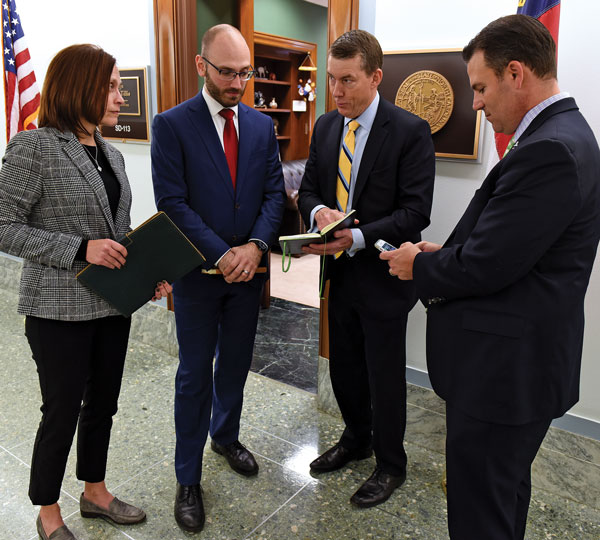 Pictured: Jill, Tristan, Craig and Tal hold a pow-wow outside of a Senate office.
Pictured: Jill, Tristan, Craig and Tal hold a pow-wow outside of a Senate office.
According to Craig, “No one day looks like the next in our space. But typically, on any given day, we’re working on a bunch of different issues.”
So how does AmericanHort decide where their focus should be and the strategies they need to use to help enact positive change in our industry? It’s a multi-pronged approach of knowing the right people and keeping your eyes and ears open. Tristan said there are a couple of ways to do this.
“One way is reactionary–what is Congressman Jones working on today? We find out what’s important to us,” he explained. “The other way is when we actually see an area that needs legislative attention and bring that to the attention of a [Congressional] member who’s in a position to affect it. We would seek them out and tell them it’s something they should care about, provide them with solutions and work with them to put together the founding coalition of a future bill.”
The other is, of course, listening to the industry’s concerns and learn about the current challenges growers and retailers are facing in their business.
“Staff don’t make these calls; we are here as professionals working on a daily basis to move the ball forward, but we’re ultimately accountable to our advocacy and public policy committee, and our board of directors and our members,” said Craig. “We have to choose our battles. As an organization, we have to
prioritze issues that we believe we can actually have an impact and that are important to our industry.”
Ken said AmericanHort’s individual membership is over 14,000—that’s a lot of people who trust that you’re representing them to the best of your ability … and that’s a lot of pressure.
But for the advocacy team, it’s all about knowing the right people, building and maintaining those relationships, which is very similar to how we conduct business in our little industry, said Tal. “It takes a lot of nurturing and fostering, and you start creating relationships and sustaining them.
“I think in order to be a good lobbyist, you have to channel the folks that you’re representing and it’s very easy to channel [the people in our industry] because they’re such good people and it’s easy to fight for them.”
11:00 a.m.
After walking around taking photos and making a quick stop in the radio and TV correspondents gallery in the Capitol Rotunda, we stop by the Senate cafeteria for a quick beverage and a chat. While I interview Jill, Craig finds a corner to make a phone call, and Tal and Tristan check their emails.
If you’ve been paying attention, then an image of Craig briskly walking through the halls of Congress, knocking on doors comes to mind when you think of how AmericanHort is representing you on the Hill (which is a totally correct assumption). But if you’ve really been paying attention, then you know that they also focus on research funding and making sure our industry is included when new regulations are introduced regarding environmental issues and crop protection tools.
If Craig, Tal and Tristan are the ringmasters, then Jill is the tightrope walker—balancing her relationships with government agencies like EPA, APHIS and USDA while trying to push for more research money, and keeping up with the latest pest problem and regulatory issue.
“Tal, Craig and Tristan have such a bigger network and base within the Capitol. I look to them for any guidance if I need to make connections with a representative. To me, that is their strength,” explained Jill. But she was quick to point out that she’s not a lobbyist in the general sense of the word—if she was, she wouldn’t be able to maintain the same kind of relationships with APHIS or USDA.
“I’m more of the town crier,” she says with a smile. “Hear ye, hear ye! Spotted Lanternfly is a problem!”
And Jill’s been busy. Just during this past year alone, she’s been working with EPA on new rules regarding chlorpyrifos and glyphosate, requesting additional funding for the Floriculture & Nursery Research Initiative and IR-4, finalizing research priorities for the Horticulture Research Institute (AmericanHort’s research division), and dealing with new pests like the European Pepper Moth and the aforementioned Spotted Lanternfly.
“We will always have new invasive insects and diseases—and quite frankly, weeds— that are introduced. That’s just a fact of our trade system,” said Jill. “Hopefully, in time, with a lot of these newer pests that are introduced, you hope that a natural enemy population will build up in time to combat it and keep the population in check so that it’s not as grave of a concern.”
And steering the conversation toward biological solutions has helped Jill gain traction with many of the agencies she works with, especially with some of the legislators who hear environmental concerns from their constituents. Telling them that AmericanHort’s best management practices with regard to pest control includes a focus on biocontrols and pollinator health makes them more willing to support additional funding.
“We can show them a good-faith effort that we’re taking this very seriously and we recognize the importance of it,” said Jill. “I think it’s extremely telling as an industry if we could step forward to say we’ve developed industry-wide best management practices and judicious use of traditional pesticides when needed. That does a lot for the industry when it’s proactive enough to develop that.”
12:30 p.m.
After parting ways with the rest of the gang, Craig and I head to Congressman John Shimkus’ (R-IL) office for a meeting that was set up with the National Milk Producers Federation and USApple, two other ag organizations that are asking the Congressman to support H.R. 5038. (Prairie Farms is one of the largest milk producers in the country with their headquarters in the heart of Mr. Shimkus’ district.) Craig went along to help carry the conversation, since there is a large nursery grower in the district.
The legislative aide listened and took notes as Craig and the three other representatives laid out the reasons for the Congressman to support the bill. There was a bit of pushback, but Craig and the others stood their ground, pointing out that Mr. Shimkus has supported similar bills in the past and that other Illinois Republicans were also on board.
On the way out, we bumped into the Congressman, exchanged pleasantries and went on our way. Later, I heard that the Congressman did end up voting for the bill, making up his mind less than 24 hours before the bill went to the House floor.
What’s the first thing you think of when someone mentions politics? Would it be “hyper-partisan” or “polarizing”? I asked Craig since he’s been lobbying for nursery and ornamentals growers for 30 years if this is the worst political climate he’s ever seen.
He pauses and says, “I do think that the forces that are driving us apart seem to have the upper hand at the moment over the forces that are causing us to pull together. There are a number of forces that, I think, have frayed at the fabric.”
But then he was quick to say, “I don’t think it’s hopeless. I would imagine anybody that’s a scholar of history would be able to speak more eloquently than me on times in our nation’s history—including not many years after the beginning of our nation—that it looked like it was all over. So I’m not suggesting that this is the most terrible thing ever, but I am suggesting that we face some systemic challenges. And we’re not going to solve them unless we get back to the realities that, in order to get stuff done, we have to learn to communicate, to listen, to understand divergent views and to seek common ground rather than everything being win-lose.
“And I think anybody who steps back and thinks about it for 10 minutes, at the end of the day, we have way more in common than we have that really divides us and we can’t lose sight of that.”
Being part of a trade association, Tal said that “you’ve got to take the activist cap off” and park your personal politics at the door. For many of the business owners in our industry, politics affects home and work, and since a lot of them are family-owned operations, those are tightly intertwined, and it can be very difficult to help their members steer through them.
“If you get 30 of our members around a table, they won’t agree on how you should do immigration or how you should do trucking, so we have to figure out what that compromise position is,” said Ken. “I think it’s less difficult for us to suspend our personal politics than it is to navigate the personal politics of our members. You have to put yourself in the members’ shoes and what’s best for the industry.”
And when it comes to navigating those treacherous waters and working with both sides of the aisle, Ken said it simply: “Craig’s the master.”
1:45 p.m.
We stop at the cafeteria in the Rayburn building for a quick snack and Craig steps outside to make a phone call. Then we head to the tunnel toward Longworth for the next meeting. I realize that my short leg strides can’t keep up with Craig’s hurried pace. This is the time I start wishing my feet were wheels …
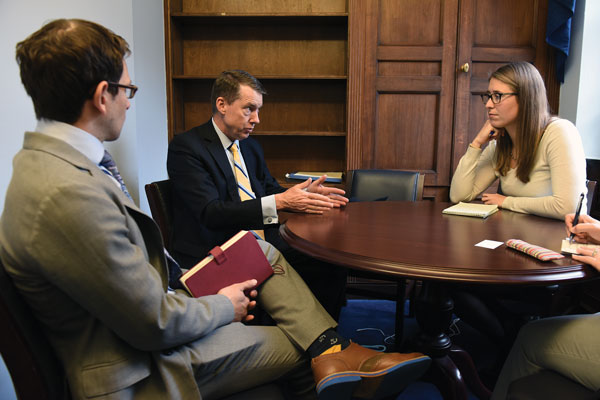 Pictured: Craig (center) speaks with legislative aides for Congresswoman Spanberger, Ari Levin and Jessie Durrett.
Pictured: Craig (center) speaks with legislative aides for Congresswoman Spanberger, Ari Levin and Jessie Durrett.
Negotiations for H.R. 5038 have been going on for months. Craig said the conversations started in April, ramped up in May and went on through the summer and September. Once the bill was officially introduced in October and passed through committee, it was finally put to a vote and passed in December.
It took months, but Craig said there were a lot of positives that allowed it to be sponsored, introduced and passed on a bi-partisan basis.
“We’re back into an environment where we can actually have a conversation about the agricultural labor crisis and how to fix the agricultural element of the problem, rather than the conversation about a bill that tries to solve everything that everybody has with the way the immigration system works,” he said. “The other thing that’s really remarkable given the general degree of gridlock and partisanship and our politics these days is that there were Democrats and Republicans seriously committed to this process—so much so, that they had their most senior staff, and many times themselves, spending hours and hours on a weekly basis.”
3:00 p.m.
We walk into Congresswoman Abigail Spanberger’s (D-VA) office for a meeting with two of her legislative aides who’ve been working closely with AmericanHort on H.R. 5038. Ms. Spanberger is one of the main sponsors of the bill and has been actively trying to garner support from other members of the House (see the sidebar on page 80).
Right before the meeting, the Congresswoman herself walks out and we chat briefly before she’s whisked away by another aide for another meeting. But the sit-down with Jessie and Ari is fruitful. Craig told me beforehand that his goal when meeting with congressional offices is to check in and talk about any obstacles as they try to move the bill forward.
And there are a few. The third Title of the bill phases in mandatory E-verify, which has been a major sticking point for our industry and in other ag sectors. The American Farm Bureau said they weren’t supporting H.R. 5038 because they felt that the timeline for the E-verify implementation was way too fast. And workers’ right groups were pushing back on the workers’ rights enforcement part of the bill because they feel it doesn’t go far enough.
But the reason AmericanHort, the dairy industry, apple growers groups and others were on board was because the status quo is bad and getting worse. Word on the street was that it’s not a “perfect” bill, but it’s a good step
forward, and that’s what matters.
While Craig’s been at the negotiating table, Tal and Tristan have been behind the scenes—Tristan pushing the message out to AmericanHort’s members and preparing the communication materials to send to House members, while Tal has put together all of the coalition meetings with other organizations. These not only include state nursery, greenhouse and landscape associations, but those in other ag sectors, and even workers’ rights and immigration groups. Legislation this important needs all of the spokes of the squeaky wheel; the more unified all of the associations are—even those on the fringes—the better, said Craig.
And the fact that this bill is supported equally by both parties has helped them garner additional support that essentially helped it pass the House.
“The only way this issue gets resolved is if there’s enough support on both sides of the aisle,” said Craig. “There is not an immigration bill that will end up passing that is only supported by one party. That’s just the history of the issue and I think it remains true today. We’re in a position where if we don’t get behind this bill now, we’re choosing the status quo.”
4:00 p.m.
Craig and I walk into Congressman Mike Simpson’s (R-ID) office where there’s a real, whole, stuffed wolf in the front office. And a lot of deer heads on the walls (being from Idaho, the Congressman is an avid outdoorsman).
We sit down with Jamie Neill, who’s been helping Mr. Simpson get more members to sign onto the bill. He said their message has been focused “on the economics of the bill”—how it helps businesses and the local economy—rather than on immigration, which has become a divisive word to many. I assume this helps the Congressman and his staff when they’re talking to the immigration hard-liners of their caucus.
Jamie mentions that the United Farm Workers were in the day before lobbying for the bill and I realize the wheels are constantly turning behind the scenes on the Hill. Similar to our industry, you can’t burn any bridges—politics and working on the Hill is all about relationship building.
As we leave, I pat the wolf on the head. Maybe it’ll bring some symbolic luck for this bill to someday be made into law.
Next, H.R. 5038 is on to the Senate and, unfortunately, the path to getting it passed isn’t as clear. One thing that is clear, said Craig, is that our government tends to be more reactionary, responding only when faced with a crisis. And Craig believes, as many of you would agree, our labor issues have reach crisis levels.
“It’s not one that results in an immediate government shutdown or grocery store shelves going empty in seven days. It is a crisis in which we are losing our economic edge,” he said. “Our motto on this stuff is we will never have the luxury of choosing our political window. The only choice we have is how prepared we are should one appear. So that’s what we’re doing on the legislative side on this issue.” GT
A Conversation with a Congresswoman
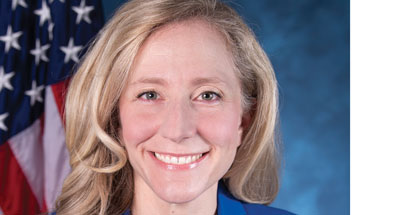 Congresswoman Abigail Spanberger (D-VA) is one of the freshman members of Congress elected during the midterms. A young mother of three daughters with an impressive background with the CIA and federal law enforcement, she was one of the main sponsors of the Farm Workforce Modernization Act, working closely with AmericanHort’s advocacy team to garner support from other House members.
Congresswoman Abigail Spanberger (D-VA) is one of the freshman members of Congress elected during the midterms. A young mother of three daughters with an impressive background with the CIA and federal law enforcement, she was one of the main sponsors of the Farm Workforce Modernization Act, working closely with AmericanHort’s advocacy team to garner support from other House members.
This past year, Congresswoman Spanberger visited Battlefield Farms and American Color—both in her district—where she sat down with the three Van Hoven brothers who own both operations to take a tour and talk about their challenges. Of course, as with almost every grower in the country, labor issues topped the conversation.
I was lucky enough to have a quick phone chat with the Congresswoman about her recent grower visits and her thoughts on the bill’s future chances.
GrowerTalks: You’re from Virginia—did you realize how much ornamental crop growing was going on in your district?
Congresswoman Spanberger: No, I really didn’t. Virginia overall has an incredible agricultural community; it’s a bit of everything. But I didn’t realize we had such a strong niche area of ornamentals in the northern portion of our district.
Before I was elected, I was going through the process of learning about the different types of agriculture in our district. I knew we had greenhouses and flower growers, but it was actually the Dutch ambassador who came to pay me a visit and said that these greenhouse businesses that I have in my district are amazing. At that point, we already had plans for me to tour, but it was really quite impressive to have an ambassador from a foreign country tell me how special the growers in our district are.
GT: You knew going into the tour you were going to see plants and flowers, but what surprised you and what did you learn (besides about the labor issues) when you were there?
CAS: Thinking through it logically, greenhouses are big operations and they’re going to be somewhat technical based on the types of plants that they’re growing, like with temperature and humidity. I knew it logically, but to actually walk into a space where from wall to wall is just flowers and recognizing that most of them started as tiny little seeds was really impressive. It’s so labor-intensive because they start so small and there’s no room for error. And also seeing some of the technology that they’re using, the way that they water the plants, the way they recycle the water—these are things I knew about, but actually seeing that was very interesting. And the level of precision focus that exists in order for that business to be successful is very impressive to see up close. Again, just the act of walking into a room and, as far as you can see, there are just rows of flowers—it’s really a beautiful sight.
One of the best parts of my job is that in order to best serve my constituents, in order to really understand the challenges businesses face, I get to sometimes have a really good, behind-the-scenes tour and the ability to jump in to see the size and scope. It gives me a whole new respect for all of the different industries across Virginia and certainly where I represent. It’s so much hard work and it brings beauty to the world.
GT: Did your meeting with the Van Hovens and hearing their labor challenge inspire you to co-sponsor the Farm Workforce Modernization Act or was it something that you were already considering?
CAS: This piece of legislation is the result of the hard work of many, many members of Congress that’s been ongoing, before I even got to Congress. My involvement on this is in the larger conversation related to immigration. I think everyone would agree that if we could wave a wand and have comprehensive immigration reform, certainly that would be ideal. But it doesn’t seem like that is going to be possible at this time. So how do you pluck out a piece that is tangible and where you’re positively impacting our agricultural communities because they need workers? Where you’re positively impacting the workers who want to come to this country and work, and they want to do it legally and they want to pay taxes, they want to be able to send money home and they don’t want to live in the shadows. How do you balance those things? Will pulling the H-2A visas out of the larger immigration debate—will that relieve some of the pressure?
Out of that was born this idea that this is a piece of the apple that we could bite off. It’s a good place for us to start and a proven concept where we can find agreement. And that we can balance some of the issues related to security, knowing who’s coming into the country and ensuring that those individuals have the proper documentation, and also ensuring that growers and producers have the workforce that they need.
Many colleagues have worked very hard coming to this agreement. A big focal point of mine was to make sure that when we talked about agriculture, we weren’t talking about “seasonal agriculture,” and to protect greenhouses and their ability to use H-2A visas for year-round workers. Luckily, many of my colleagues were on the same page.
GT: Has it been difficult to get other members to support it? It seems like you’ve been getting new co-sponsors on a regular basis.
CAS: We’re currently at 24 Democrats and 21 Republicans. Jimmy Panetta (D-CA) on the Democratic side has really been leading the charge on much of this. He’s been working on this before I got to Congress and we’ve been really pitching it and talking about it in bipartisan circles. And for particularly anyone who represents an agricultural community, this bill really resonates.
The focus has been to ensure it’s bipartisan and, frankly, to tap down some of the rhetoric that exists surrounding immigration and say it doesn’t need to be a hyper-partisan issue; there are multiple problems we have to solve related to immigration—let’s start by solving this first piece of it or at least addressing this part of the process.
GT: How hopeful are you that it will at least reach the floor of the Senate?
CAS: So I’ve stopped trying to understand what the Senate does or doesn’t do. Based on evidence on what they’re willing to do thus far, I don’t see a lot of hope for immediate progress. However, when you have an immigration bill—a heated issue that everyone seems to care about and oftentimes fight about—that is wholly bipartisan and in that effort you are meeting the needs of employers throughout our agriculture communities, you are addressing the security concerns and you are taking a piece of that larger immigration-related discussion and attempting to solve one slice of the problematic pie, I don’t see how that doesn’t get some traction.
It’s going to be incumbent on farmers and producers across the country to raise this as an issue, to make sure that everyone knows it’s a priority of theirs. And I do think that, because we’ve seen interest on the Republican side of the House, there’s space in the Republican-controlled Senate for a willingness to move it forward. So we shall see. But the level of bipartisan support that exists is a good sign that it may get traction.
I don’t love everything about the bill and I know my colleagues on the other side of the aisle don’t love everything about the bill, but it meets all of the priorities that I have—it ensures businesses have the workers, and it gives dignity and protections to the workers, so it allows for the two sides to have their needs met. And I think that’s exactly what a good bill should do and what this bill does.
—JZ